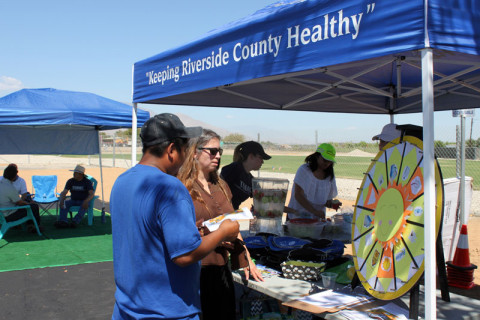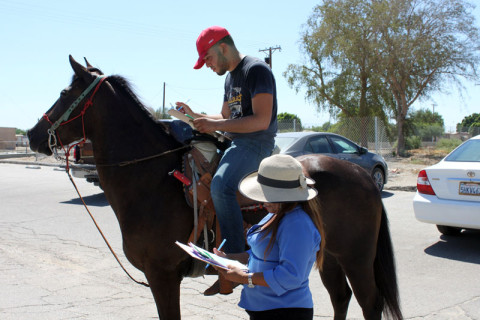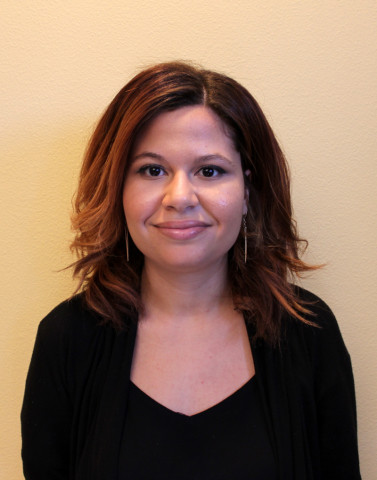
Above: The SCRAP Gallery built a temporary bus shelter prototype for the first bus shelter demonstration on Saturday, August 13, 2016 in Oasis, Calif. (Image: Paulina Rojas/Coachella Unincorporated)
By Paulina Rojas
OASIS, Calif. — Many of those who call the Eastern Coachella Valley home depend on public transportation. Even on days when temperatures exceed 100 degrees people can be seen standing at bus stops, many which lack shelters to protect riders from the sun and rain.
But there is a group of community-based organizations working to make this issue a thing of the past.
“Valley wide, there are a lot of areas without shade structures at all,” said Bill Schinsky, director of the Coachella Valley Art Center, “which is very surprising considering where we live.” The Coachella Valley sees some of the hottest temperatures in the state.
CVAC along with organizations that include Building Healthy Communities (BHC), the SCRAP Gallery, the Land Use Planning Awareness (LUPA) Project and the Women’s Policy Institute are part of the B.U.S SHELTERS collaboration.

Community members visit the Riverside University Health System booth at the bus shelter demonstration in Oasis, Calif. on Saturday, August 13, 2016. Image: Paulina Rojas/Coachella Unincorporated
In August, the group held a demonstration in Oasis where community members were surveyed on the need for shelters and were given a glimpse of a temporary bus shelter prototype built by Schinsky.
“Since I have the space and we were talking about what we wanted to see happen, it all boiled down to the fact that we would have to build a prototype,” Schinsky said. “I realized that I had materials here that I could use, so why not use it and see what happens.”
Schinsky constructed the prototype out of lumber, window and solar screen, which, provides protection against the sun.
“That was my mindset, we’re not here to build a structure, we’re here to get a point across and I think it was very successful,” he said.
Miguel Vazquez, Healthy Communities Urban Regional Planner for Riverside University Health System agrees that the demonstration was a success.
“The demonstration was a way to get a feel for the need of these structures in the east valley,” he said.
Vasquez also mentioned that during the demonstration over 50 community members stopped by to check out the prototype, which was on par with his expectations.
The Women’s Policy Institute was at the demonstration collecting community input on bus shelters and bus ridership.

Maricruz Ramirez from Lideres Campesinas helps an Oasis resident fill out a survey on bus ridership. Image: Paulina Rojas/Coachella Unincorporated
While the project is still in it’s initial phase, the next steps in the process will be to set up meetings with the local public transit agency, Sunline, to discuss options and what can be done to bring the bus shelters to the Eastern Coachella Valley.
The idea for the project was partly inspired by young people on the BHC Youth Council, who two years earlier noticed the lack of bus shelters in their community and began speaking out about the issue. Vazquez believes that the Bus Shelters project could also set a precedent for involving youth in future endeavors.
“It is especially important for youth to see that their ideas led to community transformation that brought people together,” he said.
Another component that makes the bus shelter project unique is the incorporation of art.
“It was important to bring creativity to the process. To come up with infrastructure … that is able to become part of the fabric of the community,” Vazques said. “We do want to incorporate a cultural element into the design of the bus shelters.”
This is something Schinsky can get on board with.
“There is no reason why a bus shelter cannot be creative, colorful, stimulating, besides also being practical and providing a necessity, especially in the desert,” he said.
About the author:
 Paulina Rojas joined Coachella Uninc. as a beat reporter in February 2016 after working as a city reporter in the eastern Coachella Valley for more than a year. Although born and raised in New York City, Paulina feels right at home in the eastern Coachella Valley. She loves the warmth of the people and buying fresh bread from her favorite bakery in downtown Coachella. Paulina is a graduate of the University of Houston, and her work has appeared in The Las Vegas Review – Journal, The Houston Chronicle, HelloGiggles and Vivala. View her author page here.
Paulina Rojas joined Coachella Uninc. as a beat reporter in February 2016 after working as a city reporter in the eastern Coachella Valley for more than a year. Although born and raised in New York City, Paulina feels right at home in the eastern Coachella Valley. She loves the warmth of the people and buying fresh bread from her favorite bakery in downtown Coachella. Paulina is a graduate of the University of Houston, and her work has appeared in The Las Vegas Review – Journal, The Houston Chronicle, HelloGiggles and Vivala. View her author page here.